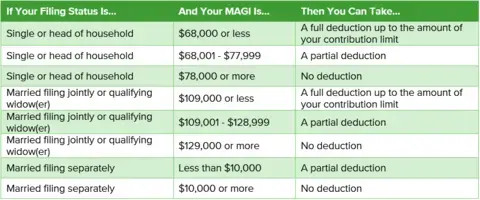Tax season can be a stressful time for many Americans. You have so many documents to keep track of and so much time spent analyzing forms, and when it’s all said and done, you may not be sure how much of a refund you’ll get—if any.
However, filing your taxes can be a much more pleasant experience when you use this time to work toward your long-term financial goals. Don’t consider filing taxes a yearly chore but an opportunity to check in with your long-term plan. Here are four ways to get the most out of filing your taxes.
1. Understand the New Tax Laws
It’s been a busy handful of years in terms of tax legislation. Since 2017, we’ve seen a lot of new tax reform.

- The Tax Cuts and Jobs Act of 2017 [AM2] changed tax brackets and eliminated many federal deductions
- 2018 saw a lot of tax legislation at the state level to more closely align with Federal changes
- The SECURE Act pushed back the RMD age to 72 and loosened some restrictions to make it easier to save for retirement
- COVID stimulus in 2020 and 2021 created additional tax breaks for those more severely affected by the pandemic
- The SECURE Act 2.0 pushed back the RMD age even further and expanded access to Roth accounts, among other strategies designed to help you save for retirement
All these changes come with new or altered regulations, and they can be hard to stay ahead of. What’s more, many of them have had significant repercussions on almost every tax filer.
That’s why understanding tax volatility is crucial to maximizing the tax-filing season. It’s essential to understand not only what the changes are but also their cumulative impact. There are opportunities in volatility, and working with your advisor and tax specialists will help you take advantage of them.
Want to minimize your tax burden? Click here for a free consultation to discuss the most tax-efficient strategies.
2. Reduce Your Tax Burden (If You Can)
A significant part of your comprehensive financial aims to reduce your annual tax burden or taxable estate. While there are steps you can take to do this on a long-term basis, tax season is also a excellent time for you to take yearly strides toward that goal.
During periods of market volatility (like what we saw throughout 2022), you might need to contribute more to your retirement accounts to meet your financial goals. If this is the case, consider maxing out your Traditional IRA contributions, as this can potentially reduce your tax burden for the year.
You can contribute up to $6,000 (and an extra $1,000 in catch-up contributions if you’re over 50) to a Traditional IRA, which you can deduct from your taxable income, provided you meet specific requirements. You can deduct the full contribution amount if you’re NOT enrolled in an employer-sponsored retirement plan like a 401(k), and you file income taxes as single, head of household, or qualifying widow(er). But if you file taxes jointly with your spouse or are enrolled in an employer-sponsored retirement plan, how much you can deduct depends on your modified adjusted gross income (MAGI), as shown in Figure 1 below.
Figure 1. Tax-Filing Status vs. IRA Deduction Limits, 2022

Source: Internal Revenue Service
Depending on where the market is, you could be making IRA contributions at a discount relative to previous years, which presents an opportunity to rebalance your portfolio.
3. Get Your Paperwork in Order
Let’s face it, tracking down all the necessary documentation to file your taxes is a drag. It’s probably the biggest reason we procrastinate come tax time. But the final deadline to file your 2022 income taxes is April 18, 2023. This means you have *checks watch* a dwindling amount of time to get your things together and prepare for your tax appointment.
Ensuring you have all of your W-2s, 1099s, and all your receipts for charitable contributions is cumbersome, but doing so ahead of time will reduce the potential for error and help you maximize your refund. Further, it will give you a sense of whether you will be taking the standard deduction or itemizing your deductions, saving you a lot of time as you prepare.
4. Use Your Refund Wisely
Many people view their annual tax refunds as a bonus from the government. They see it as free money that they get for being good citizens and paying their taxes. The problem with this line of thinking is that it is patently wrong.
If you do end up receiving one, your tax refund is simply the government paying you back for taking too much from your paychecks. So, while it’s nice to get, it’s your money you already earned.
Looking at it from this perspective might take some of the fun out of receiving a refund, but it can help you decide what to do with that money. Spending it on a frivolous purchase or a much-needed vacation might be tempting, but you should make sure you have your ducks in a row before you treat yourself.
If you are due for a return, ask yourself these questions:
- Do I have high-interest debt? Using a lump sum to pay off a credit card will save you a fortune through the year.
- Do I have enough in emergency savings? With continued talk of a possible recession and persistently high inflation, having several months of reserves for a rainy day may be more important now than ever.
- Do I have enough in my investment accounts? If you have serious concerns about meeting your retirement goals, consider using your refund to add juice to your savings.
And if you feel like you could use some help determining what to do with your refund or how to use it to reach your financial goals, don’t hesitate to speak with a financial advisor. The specialists at Wealth Enhancement have decades of experience in six areas of financial management, including tax planning, and can help you craft a plan that’s right for you.
The opinions voiced in this material are for general information only and are not intended to provide specific advice or recommendations for any individual.
A version of this article was originally published by Peg Webb in the Pioneer Press. You may view the article here.

